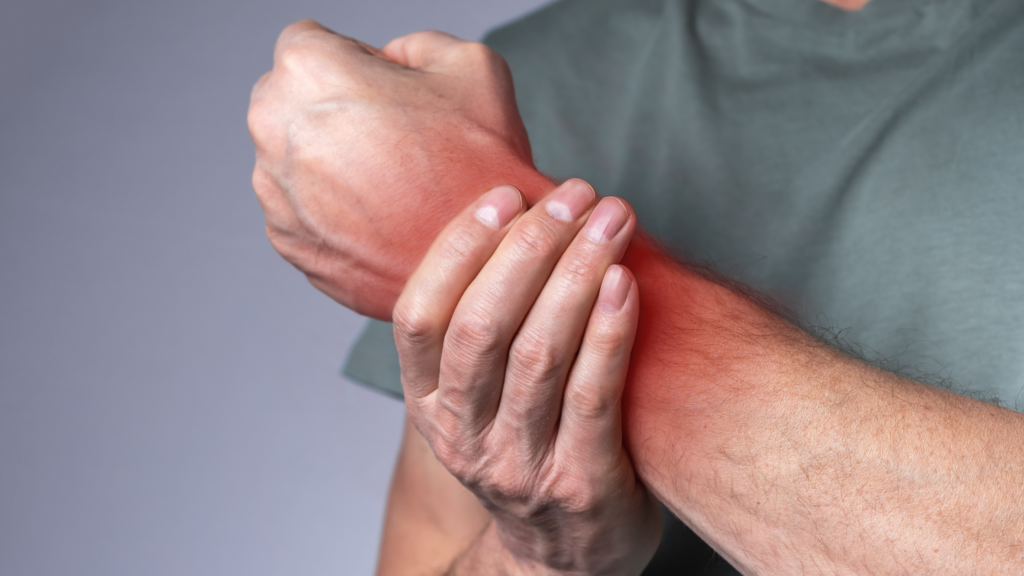This South Simcoe Physiotherapy blog post is going to take another look at an actual client – this time suffering from wrist pain and weakness. Starting with initial assessment and diagnosis of the patient, we will follow him until he is in the maintenance stage of his treatment.
The Case:
How did this individual present at initial assessment?
Patient background
The patient was a 74-year old male suffering with pain and weakness in both hands and wrists. He was also experiencing pain in both forearms and elbows, with pins and needles. The patient reported that the symptoms started after he did some renovations at his house, which involved overhead work. His pain varied between 4 and 8/10 in intensity.

Aggravating factors (things that made his pain worse): any use of hands and wrists, especially things like opening and closing doors, jar and lifting.
Relieved by: rest and a wrist brace
This individual’s pain also interfered significantly with his sleep hygiene. Client also mentioned having neck pain in the past along with headaches.
Client’s physiotherapy goals were to:
- Reduce wrist pain
- Improve sleep
- Improve wrist mobility to be able to open and close bottles/jars
- Improve strength and function of hand, so that he can resume manual labour
The Physical Examination
On observation he demonstrated forward head posture, but no atrophy (deterioration) was noticed in his hands. On examination the physiotherapist found very limited range of motion (ROM) or mobility of both wrists, and pain with all of the movements. His dominant (right ) hand also was more severely affected.
On manual resistance he reported pain in both wrists. Often we find that although the pain might be in locations such as wrist/hand, elbow and/or shoulder, the origin of it can be from cervical spine (neck). The patient’s neck was ruled out and the origin of pain was determined, through a series of tests, to be from wrist and shoulder. He reported weakness in his hands (right more than left ) but the examination ruled of any nerve damage. Upon completion of testing, client was diagnosed with bilateral carpal tunnel syndrome. Moreover, during the testing we found arthritis of all fingers on both sides.

What did treatment look like for this individual?
Stage 1: Reducing pain and inflammation
For the first 3-4 weeks the treatment goal was to reduce pain and improve sleep . This involved providing him with a brace (which is very effective in managing carpal tunnel syndrome), doing a mild dose of manual therapy and acupuncture. After 2-3 weeks he started sleeping better with reduced pain. Also he demonstrated improved mobility of his wrists. He was able use his hands a little better and was able to put Christmas lights up – a major win!
Stage 2: Improving wrist mobility:
As we continued to manage his pain we implemented a more vigorous manual therapy routine. This involved soft tissue release, joint mobilization, and stretching exercises. Also, at this point we started introducing basic strengthening and postural correction exercises. Around 6 weeks, the individual was able to move his hands/wrists with less pain and discomfort.
Stage 3: Improving strength:
Considering the severity of the arthritis and nature of the condition, it took a little longer than we expected to achieve full ROM (range of motion) of the wrists. This can be discouraging, but it is important to continue with treatment and exercises. The client was persistent and stuck to his treatment plan, and we achieved 90% of his ROM. At this time we started with specific exercises to improve strength in his wrist, forearm and shoulder muscles.
Stage 4: Activity specific exercises:
This patient is a “Jack of All Trades”. Although he is 74 years of age, his activity level is that of someone much younger. This individual is always willing to help friends and family with small and large building and maintenance projects. We started with lower resistance exercises and gradually continued to progress to more challenging exercises. He recently assembled 21 chairs – something that would have been impossible several weeks ago.

This patient is attending physiotherapy sessions once every 2-3 weeks, with a goal of maintaining his ROM and achieving increased strength.
If you are dealing with wrist pain or any other injury, and are wanting to return to your regular activities or reduce your pain, we can help. All of our skilled therapists in Tottenham and Alliston are trained in manual therapy – a very effective tool in treating any pain related condition.
